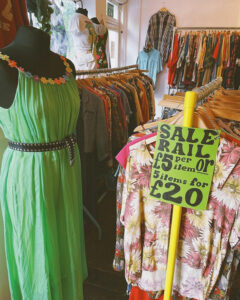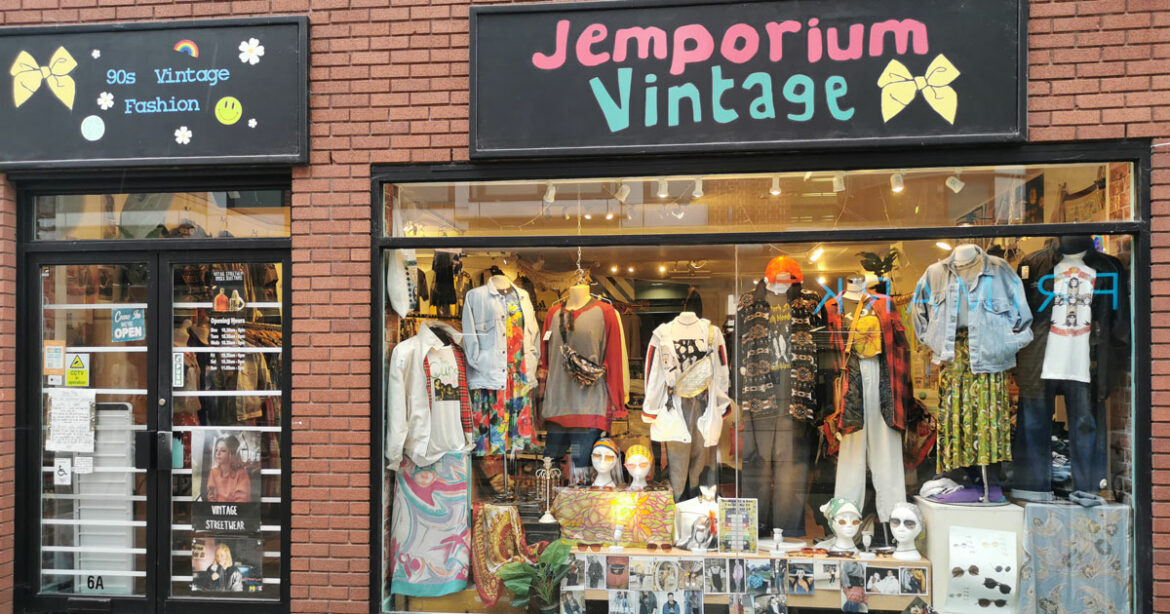Putting the brakes on fast fashion habits can be difficult, but looking for pre-loved alternatives has never been easier with these savvy city spots
Words by Alex Fice
Vintage clothing is having a moment. Once merely a matter of personal style, purchasing pre-loved is seen as a political statement these days, as the unsustainable and unethical practices of fast fashion come under scrutiny from more eco-minded businesses and consumers. Buying vintage is just one way we can slow our fashion frenzy. And fortunately for us, Cambridge is home to a growing vintage scene, offering unique, high-quality items that look great – without taking such a toll on the planet’s resources.
Quality, not quantity
Generally speaking, the term ‘vintage’ refers to any item of clothing made at least 20 to 30 years ago, with most stores stocking items from the 50s through to the 90s. This means that many of the clothes were made before production was outsourced to places like China, where clothes tend to be produced cheaply and quickly, resulting in a lower standard of product.
“Quality is a really important factor for me,” says Rachael Victoria, owner of The Serpentine Swap. “Vintage denim is so much nicer; a lot of the jeans I have in my shop are probably from the 80s or 90s and they feel great. Whereas jeans you would buy in a high-street shop today don’t have the same wear in them.”
 New lease of life
New lease of life
Thrift shops also play an important role in ensuring that perfectly good pieces of clothing don’t end up in landfill unnecessarily. The Serpentine Swap even runs a scheme in which people can bring in old clothes and exchange them for store credit. Rachael is keen on upcycling and has recently been making bags from vintage children’s bedsheets, plus there’s an in-house mending service.
Jemporium Vintage is also big on repairs, with every member of staff trained in sewing on buttons and upcycling broken items: “With everything that comes in, there’s usually something that needs fixing,” explains owner Jenny Skilton. “For example, if we get a shirt and it has a tear in the bottom half, I’ll turn it into a cropped shirt and then use the leftover fabric to make scrunchies, so nothing gets wasted. We also have a £5 box where we put other items that need repairing; we go through it about twice a year, and take anything left over to a charity shop.”
Single-wear saviours
One of the main methods of reducing wasteful fashion habits is buying less and making sure to wear any new clothing multiple times – nothing is more prodigal than buying an outfit and only using it once. But there’s one item of clothing where this usually isn’t possible – and that’s your wedding dress.
After struggling to find a vintage gown for her big day, Siobhan Mulholland-Cox decided to start Cambridge Vintage Bridal, which she runs on Etsy: “It really struck me that a wedding dress is regarded as a ‘single-use item’, which seemed crazy to me. So I set out on a mission to source awesome vintage gowns and get them back into the retail chain.”
Siobhan curates vintage wedding dresses from the 20s to the 80s, sourcing gowns from their original owners. Sometimes these pieces come with amazing stories, Siobhan explains. “I have had two 20s gowns in my possession in the past couple of years. One was made at Liberty London for a staff member back in 1928, and the other was made in Paris for a 1929 society wedding. I’ve also had a Bill Belew gown, which I sold at a wedding fair in London – Belew was an American costume designer who created stage outfits worn, among others, by Elvis Presley.”
Many stories to tell
Vintage clothing often has a bit of a tale behind it, and that’s what makes it so special. In her 50-plus years of trading on the market as Cambridge Market Retro, Susan Dix (Dixie, for short) has seen how vintage has attracted people from all different backgrounds, including Argentinian jockeys, national treasures and singing superstars. “When Katrina and the Waves were doing the Eurovision Song Contest, Katrina was taken to be dressed by a stylist – but she didn’t like that one tiny bit. So, unbeknown to them, she came to my stall and bought the outfit she won in! I love the fact that she came and bought her outfit from us.” The clothes themselves also tell a story, with reports of ticket stubs, old coins and matchbooks in pockets that hint at adventures from their previous owners’ lives.
The future of vintage
Although buying vintage is a more sustainable option than fast fashion, it does have drawbacks. With only a limited supply of genuine vintage pieces in circulation, and new clothes no longer being made to last, the future looks uncertain: “Wholesalers have started raising their prices. They say it’s because shipping costs have gone up since Covid-19,” says Rachael. “It’s getting more competitive now, too, due to the growing interest in second-hand clothing.”
In the years to come, it will be important to make sure that we don’t put all our clothes in one basket, so to speak, when it comes to sourcing more sustainable looks. Head to your local charity shops, see what you can find on sites like eBay, Depop and Vinted, and make sure to replenish the supply of vintage and pre-loved clothing with your own unwanted items. You never know… an old jacket could become someone’s next wardrobe favourite.
For more from the Eco Cambridge series, check out this article on repair cafes and circular economies in and around Cambridge.

